A good day for a wild burro named “Piper”
On a dark night in August, Darwin resident Steven Heller opened his front door to see a visitor. Not a neighbor, but a wild burro standing several feet from his porch, staring straight at him.
In many other towns, a wild burro at your front door is a startling sight, but in Darwin, Calif., human visitors are rare and wild burros are regular and welcome guests. Wild burros frequently wander into town from the Centennial Herd Management Area, walking the roads or stopping for a drink from the overflow of the town’s water tanks.
Darwin is a tiny former mining town found at the western edge of Death Valley, near the entrance to Death Valley National Park. Named after Darwin French, a local rancher, miner, and explorer, Darwin has no businesses or services, just a single stop sign, a U.S. post office, and a community garden. The occasional human visitor may think they stumbled into a ghost town due to the style of structures and scenery, but about 30 residents live in Darwin year-round.
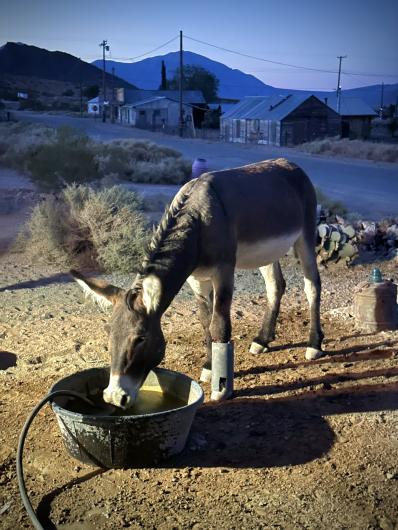
“In this town, everyone not only knows your name, but when you blow your nose, when you go to sleep, when you got mail at the post office, what you ordered from Amazon,” said Heller.
Heller moved to Darwin from Los Angeles in 2021 to start a new, quieter chapter of life. A frequent visitor to the high desert, Heller settled on Darwin for the peace and quiet after he retired from his career as a photographer and teacher. When he arrived, he noticed about 10-12 wild burro “regulars”, walking down the roads, circling the town, and making their own paths, typically in the wetter months. About 75 wild burros roam the area around Darwin and have become a regular sight for the town’s residents, and an exciting conversation topic.
So, when Heller swung open his front door in August, what surprised him wasn’t the wild burro, but how the burro was looking at him.
“It was one of the most amazing moments I can recall with an animal,” exclaimed Heller. “The burro was looking at me as if to say, “please help me.””
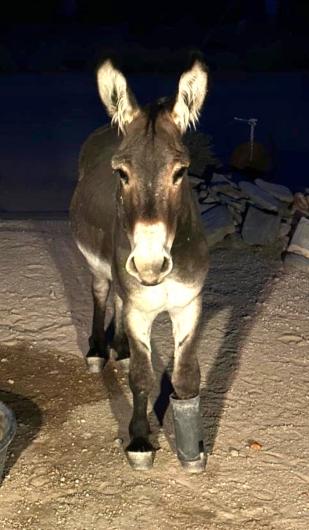
Through the darkness, Heller noticed something on the burro’s front left leg. Always the photographer, Heller snapped some photos which revealed a PVC pipe caught on its leg, covering the top of the hoof, and ending just below the knee. After their first encounter, Heller named the wild burro “Piper,” who continued to visit his house, walking abnormally due to the restrictions of the pipe.
“For several weeks, Piper kept showing up at my house with the same “please help me” look. I called animal control, livestock vets, I wanted to get him some help,” said Heller. “I didn’t have a good contact at the BLM, but I also didn’t have the greatest impression or knowledge of the BLM.”
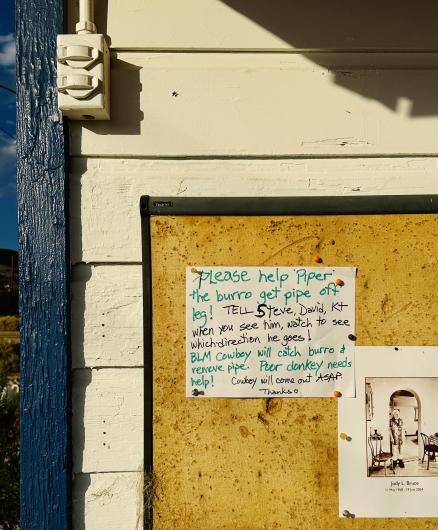
The BLM manages public lands for a variety of uses including energy development, livestock grazing, recreation and more, while protecting natural, cultural, and historic resources. The BLM is also responsible for managing and protecting wild horses and burros per the Wild-Free Roaming Horses and Burros Act. Since the BLM’s multiple use mission balances many different uses of public lands it often leads to contrasting interest groups and varying opinions about the agency, including in Darwin. Eventually, through a neighbor, Heller was connected with Alex Neibergs, BLM Wild Horse and Burro Specialist for the Ridgecrest Field Office.
“Alex stepped into the picture with amazing grace, expertise, and compassion. He knew exactly what to do and how to do it,” said Heller.
Meanwhile, the news of Piper quickly spread through town, with the common goal to help. When Piper was spotted by residents, he was now limping. It was time for action.
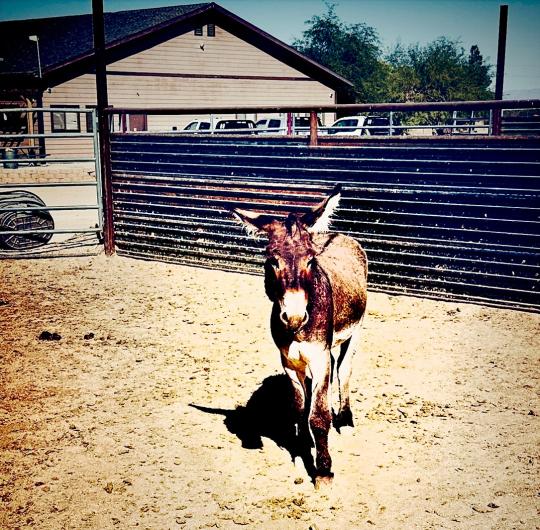
In early October, the BLM set up a corral near Heller’s house to capture Piper and transport him to the BLM’s Ridgecrest Regional Wild Horse and Burro Corrals – a 80-acre facility that prepares wild horses and burros for public adoption which includes vaccinations, deworming, blood tests, and freezemarking. At the facility, Neibergs and other BLM staff cut the pipe off and Piper remained at the facility for a few days to recover. With the corrals at capacity, after making a full recovery and starting to walk normal again, Piper was released back to Darwin, pipe free.
“The rescue effort for Piper with the support of the Darwin community reflects the compassion we share for the wild burros and what can be accomplished working together,” said Neibergs.
Heller will never forget his firsthand experience with the BLM and the people who now make up the face and his newfound impression of the agency. He no longer sees the BLM as a faceless government agency, but as the dedicated and compassionate employees behind it including Alex Neibergs; John Thomas, a BLM park ranger; and Benito Beasgarcia, a BLM horse wrangler at the Ridgecrest Regional WHB Corrals.
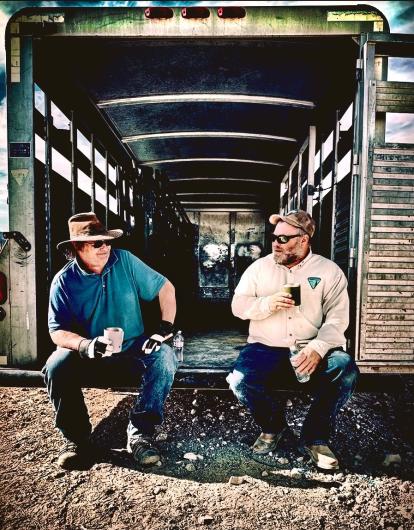
“This interaction with the BLM made a huge difference to me and the town of Darwin. Wild burros are very treasured out here and give the town some character,” said Heller. “Every BLM employee we met through this experience was professional and detailed. I’m thankful for this amazing experience with the BLM and it was a good day for Piper.”
Heller saw Piper a few nights after his release, his leg almost completely healed. He continues to keep an eye out for Piper, but without the pipe, he is now indistinguishable from the pack.
Photos curtesy of Steven Heller.
Kate Miyamoto, Public Affairs Specialist, California Desert District
Related Stories
- BLM recreation sites available to all: Exploring accessibility on California’s public lands
- BLM California partners to secure America’s border
- Meet the Engineers: BLM California celebrates 2025 National Engineers Week by getting to know some of our finest!
- Honoring Excellence in Service: Ranger Perez Recognized as BLM California Ranger of the Year
- How fuel breaks helped wildfire agencies contain the Grove 2 Fire in eastern San Diego County
